Wisconsin’s Ozaukee Interurban Trail
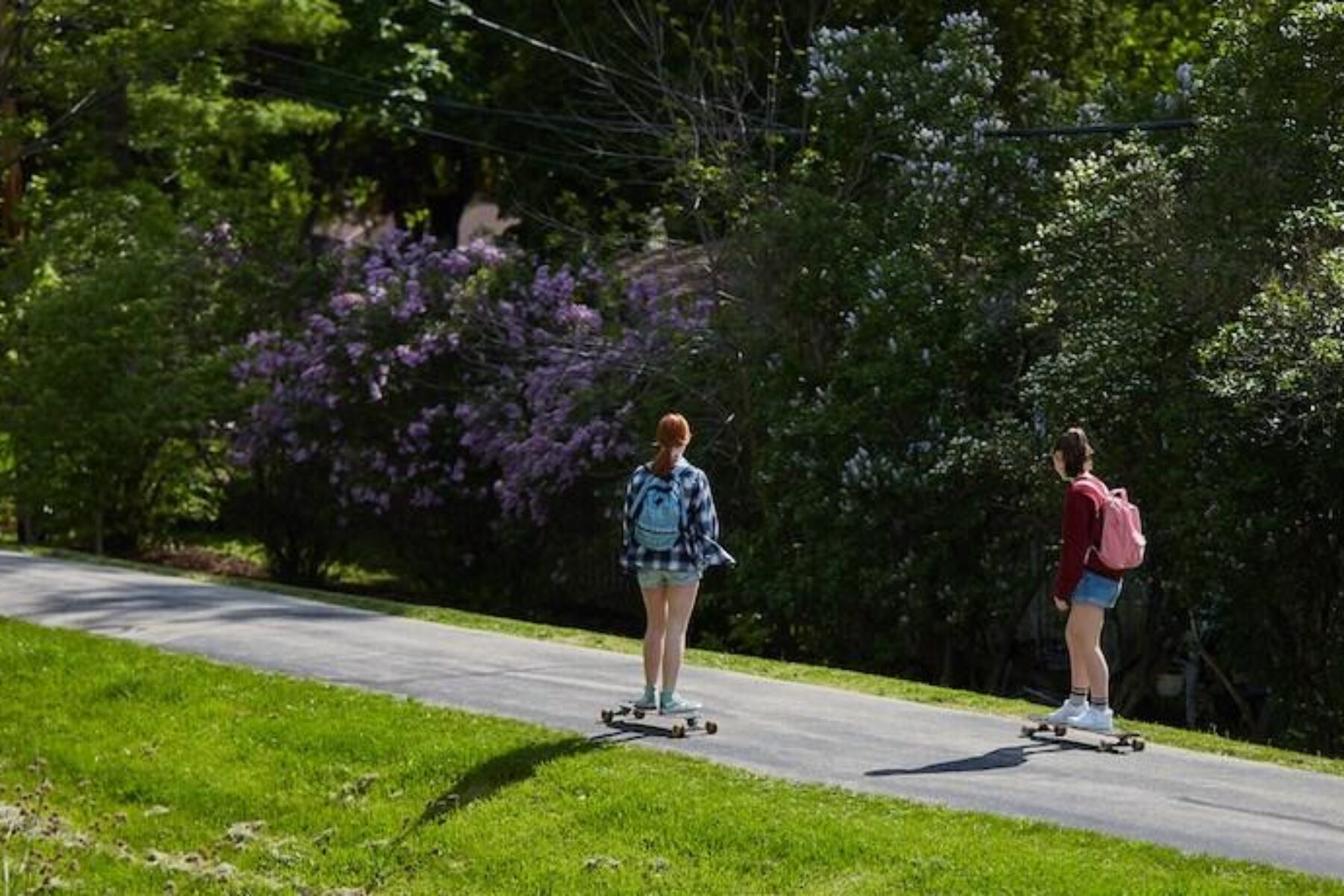
Trail of the Month: April 2023
“The trail is a large factor for health and wellness in the county … On any given day, there are hundreds of people using the trail for recreation, health and well-being.”
—Andrew Struck, Director of the Ozaukee County Planning and Parks Department
Sometimes there are trails that seemingly take visitors through every conceivable environment: vibrant urban locales to quaint small towns to nature at its very best with woodlands, wetlands and even the shores of a Great Lake. This is the Ozaukee Interurban Trail, a paved, 30-mile route flanking the Milwaukee River and Lake Michigan through the northern suburbs of Milwaukee, Wisconsin.
Passing through the historic downtowns of Cedarburg, the Village of Grafton and City of Port Washington, it spans the entire length of Ozaukee County from north to south. Trail users can also take shorter excursions of five, 10 or 15 miles between smaller communities like Mequon, Thiensville and Belgium. All in all, the trail goes through eight of Ozaukee County’s 16 communities.
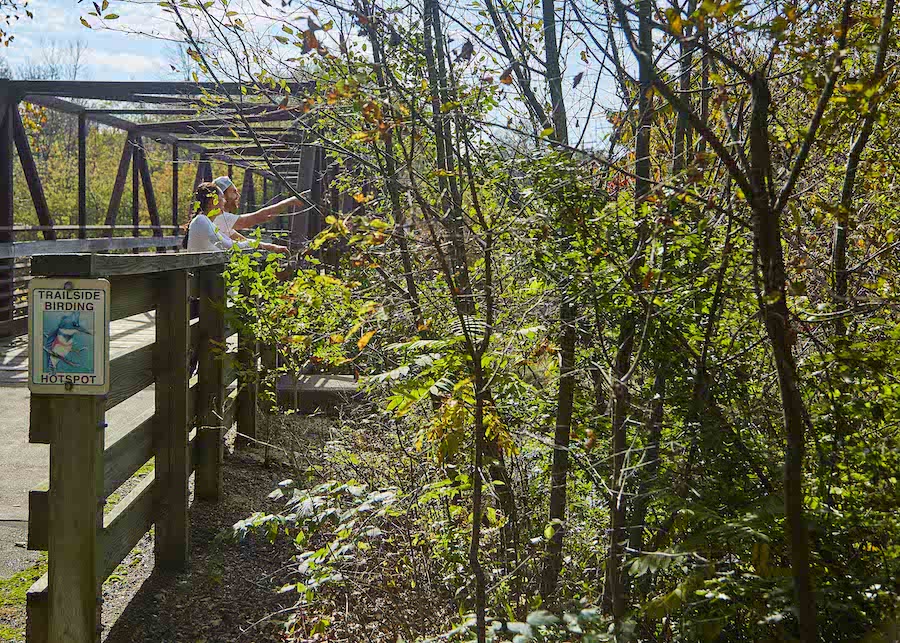
“The trail not only accommodates all-season, nonmotorized vehicle recreational uses such as hiking, walking, running, biking, inline skating, wildlife viewing and skiing, but also is an integral feature in connecting Ozaukee County’s commuters to places of employment, business, industry, historic places and commerce,” explained Andrew Struck, director of the Ozaukee County Planning and Parks Department and chairman of the Ozaukee Interurban Trail Advisory Council. “In fact, the Ozaukee Interurban Trail is a key element in Ozaukee County’s overall transportation plan for the county.”
Railway History With a Side of Blues
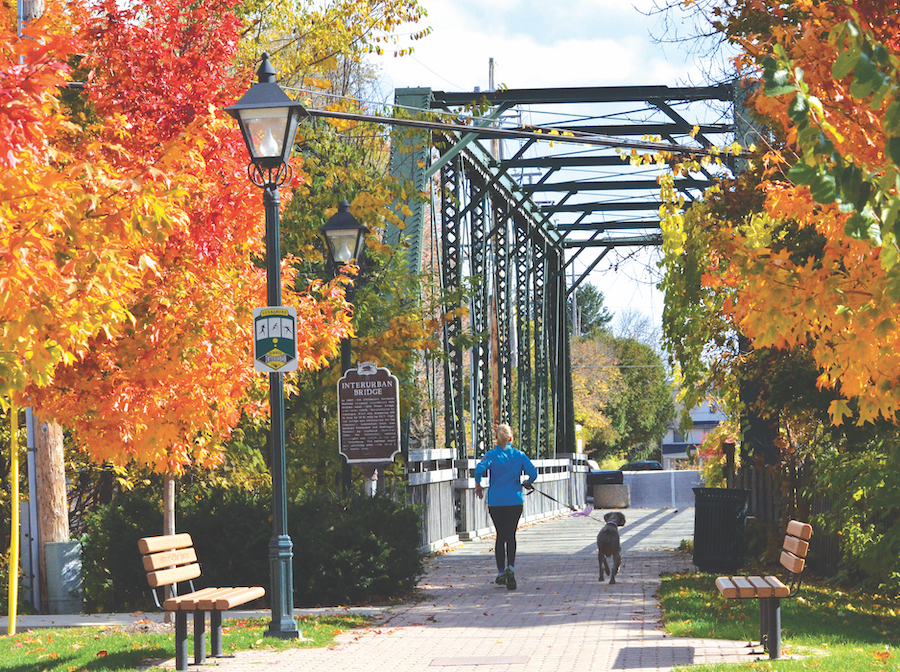
The rail-trail follows the bygone railway bed of the Interurban Electric Railway, and nods to this history can be found in Cedarburg, home to one of the original railway bridges and the Cedarburg Railroad Depot, which has been lovingly restored and features a museum and archive.
From 1908 to 1951, the railway operated a passenger line between Milwaukee and Sheboygan. Some of the most famous individuals who rode these rails were a bevy of blues singers who traveled north in the 1920s and ’30s on their way to a recording studio located in the Grafton chair factory, which eventually became Paramount Records. Elizabeth Mueller, the tourism promotion coordinator at the Grafton Area Chamber of Commerce, points out an attraction just a block off the route in Grafton that ties into this piece of music history.
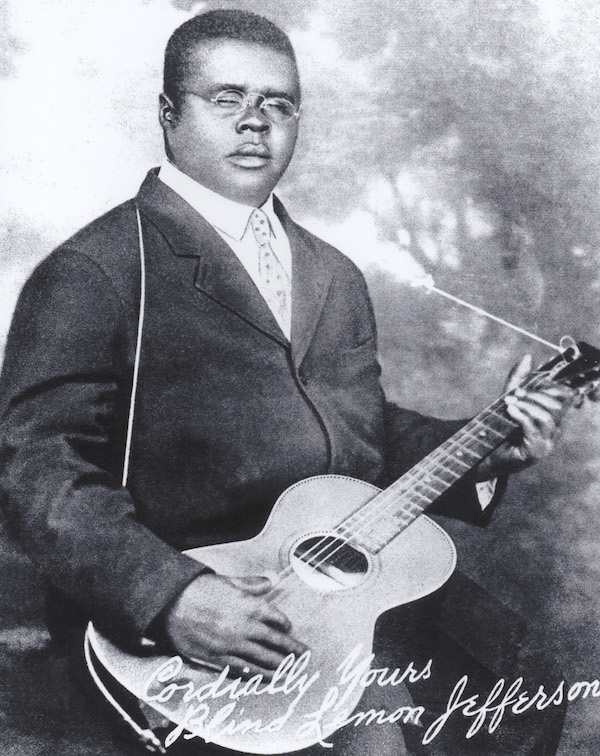
“Paramount Plaza, with its distinctive Walk of Fame sidewalk resembling a piano keyboard, recognizes the important role that the Paramount Records recording studio and record-pressing plant played in blues music history and the achievements of the mostly African American musicians who recorded for the label,” she said. “These musicians traveled by train to Grafton to record their music. You’ll find tributes to legendary blues artists like Ma Rainey, Louis Armstrong, Blind Lemon Jefferson and Charley Patton, who is often recognized as ‘the father of the Delta Blues.’”
In 1975, Wisconsin Electric (now known as We Energies and the largest provider of electricity and natural gas in the state) was persuaded by a dedicated group of local citizens to begin converting portions of the rail corridor into bike paths. By 1998, Ozaukee County, along with many of its communities, received the state funding they needed to lease the land from the electric company and fill in the remaining gaps in the Ozaukee Interurban Trail. It was finished four years later and named Wisconsin’s “Trail of the Year” in 2002.
Impact in the Community
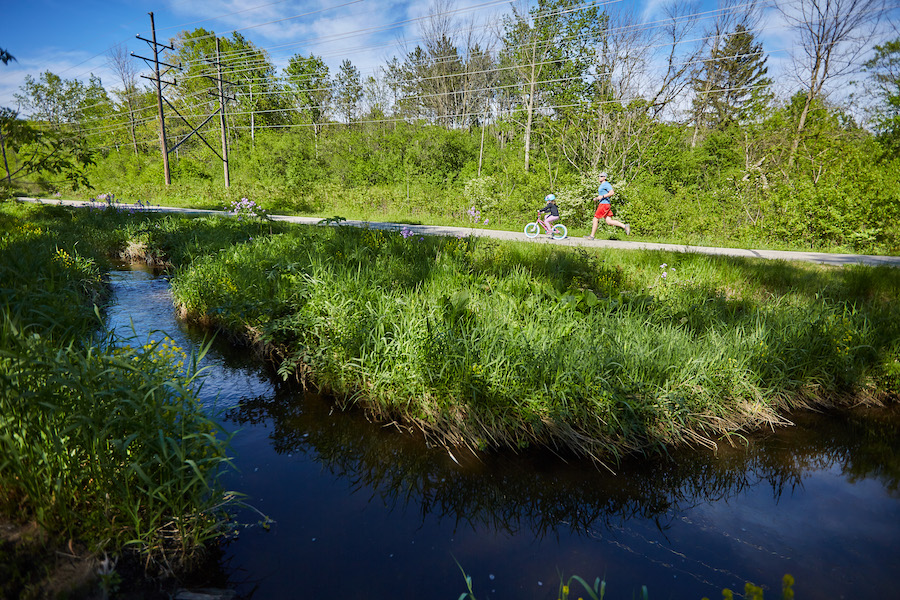
Although many trails in Wisconsin require the purchase of a state trails pass to use them, the Ozaukee Interurban Trail is free, making it a popular choice. Between 2019 and 2022, the trail averaged 350,000 to 500,000 trail users annually, which may have helped buoy Ozaukee County’s ranking as the healthiest county in the state in 2022.
“The trail is a large factor for health and wellness in the county and has been supported by many healthcare agencies,” Struck said. “Ozaukee County encourages its employees to use the trail for health and wellness. On any given day, there are hundreds of people using the trail for recreation, health and well-being.”
One of its draws is the opportunity for people to get out in nature and see wildlife. Since the trail runs adjacent to many bodies of water, including the Milwaukee River, Cedar Creek and the Lake Michigan shoreline, animals abound. People frequently spot deer, foxes, frogs, salamanders, snakes and turtles. But the trail’s real claim to fame when it comes to wildlife is that it’s a bird watcher’s paradise. You can download a birding guide to find the trail’s best locations for spotting them and look for the “trailside birding hotspots” signs along the path.
“The trail has been designated as a ‘Great Wisconsin Birding and Nature Trail’ by the State of Wisconsin, the first trail in the state to carry this designation,” Struck said.
“There are also several lakeside parks in the City of Port Washington and also the historic Port Washington lighthouse and station, as well as the new Wisconsin Shipwreck Coast National Marine Sanctuary, where you can learn about Lake Michigan’s historic shipwrecks and efforts to preserve them and Lake Michigan,” he continued.
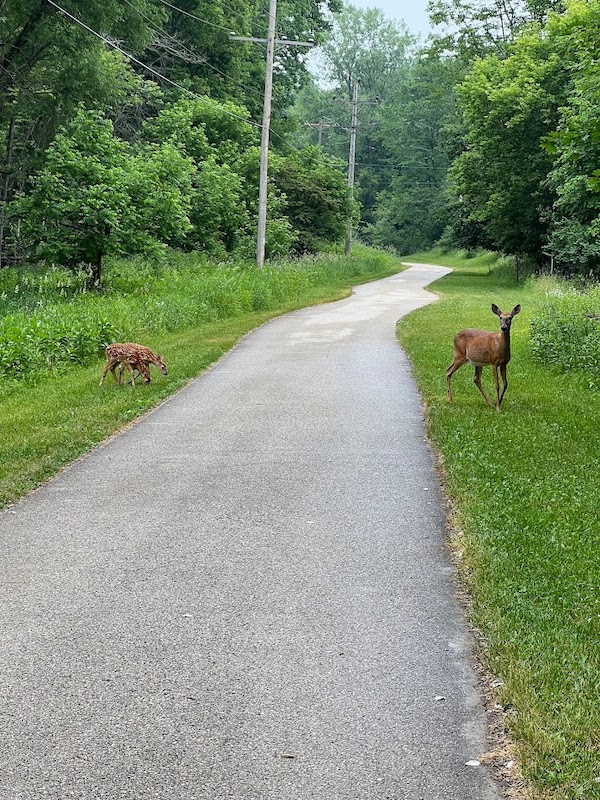
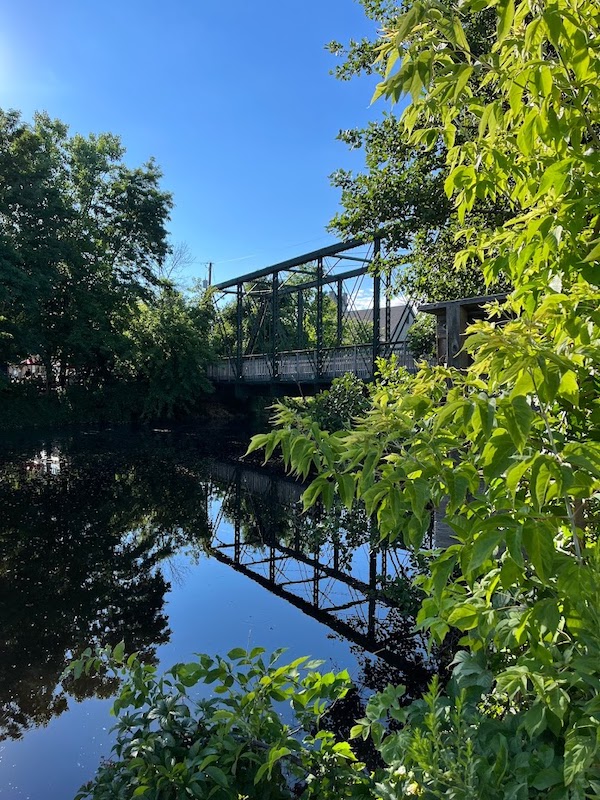
With so many notable attractions along the way, the county can count on tourism dollars from trail users, and trailside communities have seen a positive economic impact from these visitors patronizing local businesses. A 2016 report by the University of Wisconsin-Extension Ozaukee County analyzing trail user surveys from 2009 and 2013–2014 found that about a third of the respondents spent money on restaurants and taverns while using the trail. And in both surveys, 99% of respondents said that they planned to visit the Ozaukee Interurban Trail again.
“The community of Grafton has made a conscious effort to be biker friendly,” noted Mueller. “For example, part of the development of new businesses is to incorporate bike racks into their plans. The warmer months bring lots of pedestrians and cyclists out into our communities, but there are several mornings even in the winter months that I see rows of fat bikes lined up outside one of the many coffee shops in downtown Grafton.”
Related: Trail Moments | A Tale of a Tour: Traveling by Trail in Wisconsin
Making Connections
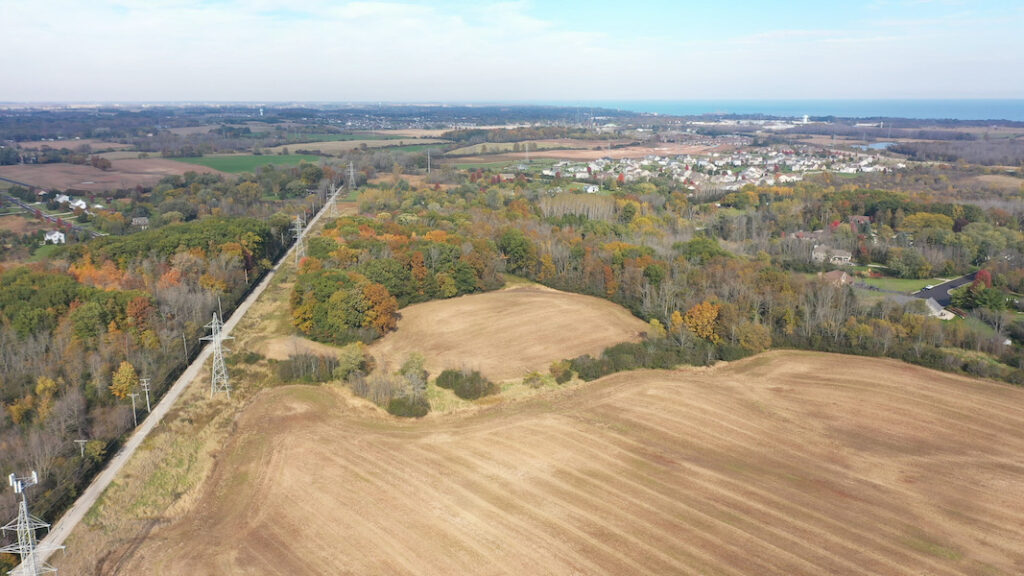
To continue positive experiences on the two-decades-old trail, work to repave its northern half is slated for 2024–2025 and was supported by nearly $1 million from the Transportation Alternatives program, the nation’s largest dedicated source of funding for trail and active transportation projects. Additional support for the region’s trails may come from Wisconsin Gov. Evers’ 2023-2025 budget, which calls for spending more on the state’s active transportation network.
With multiple connections to other trails, the Ozaukee Interurban Trail expands the options of the destinations and communities that people can reach without a car. On its southern end, the trail is seamlessly connected to the milelong Brown Deer Recreational Trail, which in turn provides a link to the Oak Leaf Trail spanning 125 miles throughout the Milwaukee metro area. And on its northern end, the connecting Sheboygan Interurban Trail continues 14 miles north to Sheboygan.
Related: The Way Forward: Milwaukee County’s Oak Leaf Trail
Adding to its value is the trail’s role in the regional Route of the Badger trail network, a TrailNation™ project being spearheaded by Rails-to-Trails Conservancy with support from local partners that’s connecting communities across more than 700 miles of trail in the southeastern corner of the state. Willie Karidis, RTC’s project manager for the Route of the Badger project, explained that the Ozaukee Interurban Trail currently has three potential new connections to the Route of the Badger trail network. This includes trails along the Milwaukee River north to Saukville; west along Highway 60 to a future southern extension of the Eisenbahn State Trail; and south along the Little Menomonee River.
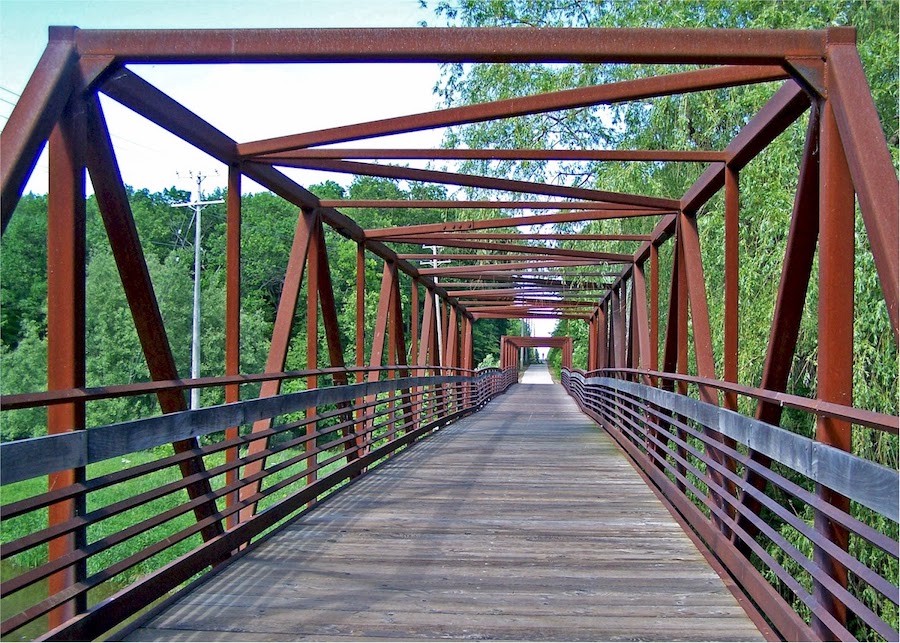
“While all three of these trails are not imminently planned, the importance of the Ozaukee Interurban as a signature trail in Southeast Wisconsin makes all three of these projects more plausible and important to the communities they run through,” Karidis remarked.
The Ozaukee County Planning and Parks Department has been involved with this coalition of partners since its inception, Struck noted. “We are extremely supportive of the Route of the Badger initiative because the connectivity of a regional trail system is just as important as the connectivity of the road system. The Ozaukee Interurban Trail becomes so much more valuable in terms of tourism, economic development, quality of life and health benefits when it’s connected to the region and beyond.”
Related: Top 10 Trails in Wisconsin
From Rails To Trails Magazine: New Power Generation
Wisconsin’s Route of the Badger
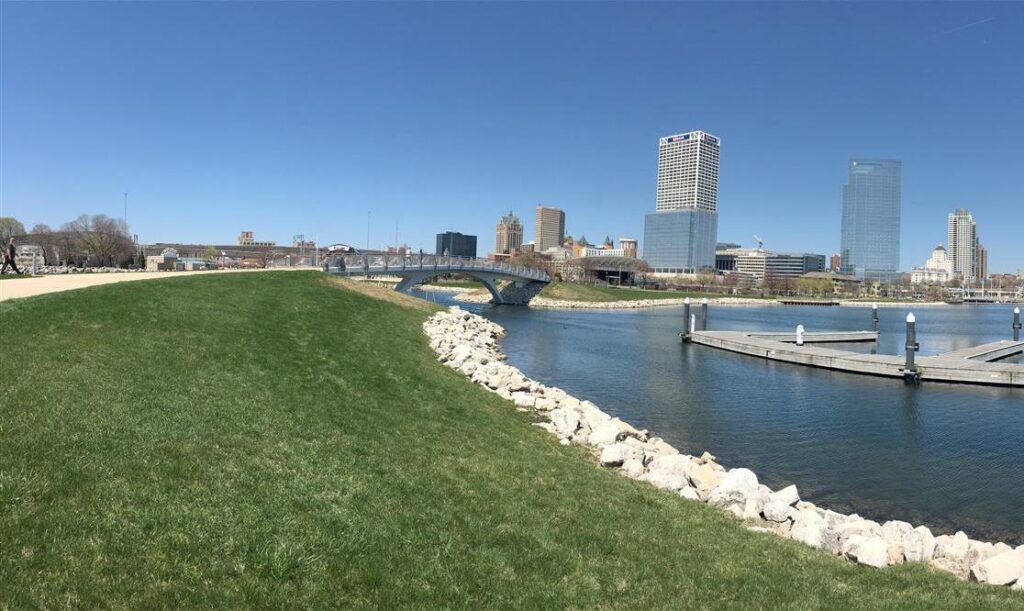
The Route of the Badger is a developing 700-miles-plus regional trail network that aims to create equitable connections to critical destinations and premier cultural attractions throughout Southeast Wisconsin. When complete, this transformative TrailNation™ project will stretch from Milwaukee to Dousman, and from Sheboygan to Kenosha.
RTC’s TrailNation initiative encompasses model trail network projects that connect across city, county, multi-county and multi-state lines. Through these projects, RTC and our partners are demonstrating what’s possible when equitable trail networks are central to community design and what it takes to make this infrastructure essential.
Related Links
- Ozaukee County Planning and Parks Department
- Ozaukee Interurban Trail Advisory Council
- Route of the Badger
Trail Facts
Name: Ozaukee Interurban Trail
Used railroad corridor: Interurban Electric Railway
Trail website: Ozaukee Interurban Trail
Length: 30.1 miles
County: Ozaukee
Start point/end point: W. County Line Road and the Brown Deer Recreational Trail, 0.4 miles west of WI 57 (Mequon), to County Road K and the Sheboygan Interurban Trail, 0.8 miles west of County Road LL (Cedar Grove)
Surface type: Asphalt
Grade: Although relatively flat (with an average grade of 5%), the trail has three grade changes of significance. The largest and longest elevation change occurs coming in and out of the City of Port Washington. The second largest elevation change is on the north end of the City of Mequon by Mee-Kwon County Park, and the third elevation change of note is just north of the trail crossing over the Milwaukee River in the Town of Grafton.
Uses: Walking, biking, inline skating and cross-country skiing; wheelchair accessible
Difficulty: Easy; the trail is relatively flat and paved.
Getting there: The nearest commercial airport is General Mitchell International Airport (5300 S. Howell Ave., Milwaukee), located just over 30 minutes from the southern end of the trail. At the airport, you’ll also find an Amtrak station if you prefer riding the rails. Another Amtrak station in Milwaukee—the Intermodal Station (433 W St. Paul Ave., Milwaukee)—is also around 30 minutes from the trail.
Access and parking: Select parking lots for the trail are listed below from south to north. For additional options, visit the trail website (interurbantrail.com/parking).
- Mequon: Mequon City Hall, 11333 N. Cedarburg Road
- Thiensville: Municipal lot on Buntrock Avenue, 250 feet west of N. Cedarburg Road
- Cedarburg: Municipal lot at Turner Street and Hanover Avenue
- Grafton: Veterans Memorial Park at 13th Avenue and Washington Street
- Grafton: Meadowbrook Park, 649 N. Green Bay Road
- Port Washington: Interurban Pocket Park, 741 W. Oakland Ave.
- Belgium: Village Park, 106 Beech St.
To navigate the area with an interactive GIS map, and to see more photos, user reviews and ratings, plus loads of other trip-planning information, visit TrailLink.com, RTC’s free trail-finder website.
Rentals: Located directly next to the southern end of the Ozaukee Interurban Trail in Mequon, you’ll find Trailside Recreation (11090 N. Weston Drive, Mequon), which offers bike rentals.

Donate
Everyone deserves access to safe ways to walk, bike, and be active outdoors.
